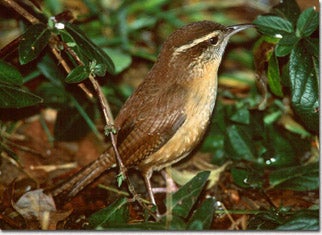SCIENTIFIC NAME:
Thryothorus ludovicianus
OTHER NAMES:
Great Carolina Wren, Mocking Wren and Florida Wren.
STATUS:
Breeder. Common in all seasons and regions. Lowest Conservation Concern.
DESCRIPTION:
The Carolina wren (Thryothorus ludovicianus) is a small bird in the family Troglodytidae. It is approximately five and one-half inches in length with a deep rusty-brown colored back, buff colored underside, light colored throat and prominent white stripe above and beyond the eye. A Carolina wren’s call is a loud melodious whistled “TEA-kettle TEA kettle TEA-kettle” or “cherry cherry cherry.” Carolina wrens will call at any time of the day or year.
DISTRIBUTION:
Carolina wrens are commonly found in the southeastern United States. They range as far north as southeastern Ontario, Canada, and as far west as eastern Oklahoma, Nebraska and Texas.
HABITAT:
Woodland thickets, ravines and rocky slopes covered with brush, as well as wooded suburban areas.
FEEDING HABITS:
Carolina wrens are primarily ground foragers, hopping and flitting on the ground, turning over leaf litter and investigating small cracks or crevasses around tree roots or stumps to find food items. Their diet consists primarily of insects, including beetles, caterpillars, moths, crickets, bees and ants. Carolina wrens are also seen “hitching” up tree trunks in a similar fashion to nuthatches or creepers. They will probe the bark for prey items such as spiders or snails. Their diet rarely includes seeds, acorns, or other vegetable matter. Carolina wrens can be attracted to feeding stations near brush piles or other brushy cover by providing suet, peanuts or sunflower seeds.
LIFE HISTORY AND ECOLOGY:
Carolina wrens are monogamous, maintaining pair bonds and territories throughout the year. Both sexes use songs and calls to defend their territories. All nesting, foraging, and feeding of nestlings occurs within the territory. Pairs may bond at any time of the year. Males court females intensively, hopping about the female with their tails pointed straight up and puffing out their body feathers. Males may offer food items to the females during courtship and the early stages of nest building.
Males build several nests but the female chooses only one for the season. Nests are usually built in enclosed areas such as natural cavities in trees, vine tangles, upturned tree roots, tree stumps or abandoned woodpecker holes. Carolina wrens will readily nest in nest boxes and other less-natural man-made oddities such as a tin cans, mailboxes, old boots or shoes, and watering cans. Almost anything that forms a protective cavity will do. The nest is dome shaped and made with a variety of materials including grass, leaves, sticks, pine needles, mosses, feathers, straw paper, string, and even shed snake skins. Nests are lined with hair or fur. Nests are rarely located more than 12 feet above the ground.
Clutch size normally ranges from four to five eggs. Eggs are creamy white, heavily spotted with purplish-brown to rusty brown flecks. Eggs are laid at a rate of one per day. Only the female incubates the eggs. Incubation begins the day the last egg of the clutch is laid. The incubation period lasts 12 to 14 days. During this time, the male often brings food to the female on the nest. Eggs hatch within 24 hours of each other. Females will brood the young for the first four days after hatching. As the young grow, the female will brood only at night, helping the male collect food and feed the young during the day.
After 12 to 14 days, the parents will coax the young from the nest. Initially, fledglings will hop and fly only short distances. Fledglings will stay together and are fed by both parents. If the female begins another nesting attempt, the male will be left alone to care for the fledglings. Approximately four weeks after fledging, the young are independent. After reaching independence, young Carolina Wrens move out of their parents’ territory. – usually staying nearby, but setting up new territories. Carolina Wrens raise two to three broods each year.
Carolina wrens are non-migratory. At the northern edge of their range they increase in mild years, but severe a cold season with heavy snow will decimate their numbers.
Author:
Ron Eakes, Wildlife Biologist, Division of Wildlife and Freshwater Fisheries






